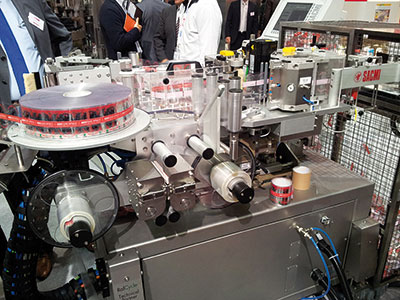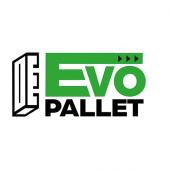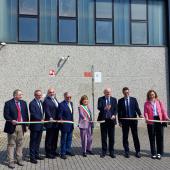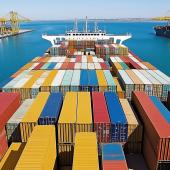Self-adhesive labeling machine: significant innovations
The Sacmi Group has developed a compact labeling machine, able to perform the loading and unloading of the material completely automatically at the maximum operating speed (up to 60,000 b/h). Innovative too the management of the waste liner.
 At drinktec 2013, with a large stand that won the BeverageDaily first prize, Sacmi presented an innovative solution for self-adhesive labeling, which has captured the attention of the public.
At drinktec 2013, with a large stand that won the BeverageDaily first prize, Sacmi presented an innovative solution for self-adhesive labeling, which has captured the attention of the public.
It is a fully automatic station, designed by Sacmi Labelling, which does not require downtime or slowdowns for reel changes and thus always works at full speed with high positioning accuracy (± 0,5mm).
«An extraordinary result - says Ermes Belicchi, General Manager of Sacmi Verona SpA - which, however, would not have been enough without a similar device for rewinding the label backing film on the fly. We devised the same in collaboration with UPM Raflatac, who provided its Proliner PP 30 on reels made by the converter Label It, according to the particular specifications.
And not only that: the support film is recovered in small compact reels, without residual labels and without the cardboard core, hence ready for recycling». This has allowed Sacmi to become the first OEM with the qualification of Rafcycle Technical Partner.
Less costs, no stops. Sacmi’s self-adhesive station has been masterfully constructed using quality materials and components, aiming at facility of use and maintenance (the semi-transparent structure enables the monitoring of the production and the identification of any problems.) «Its distinctive and main strength, however, is the automatic enslavement of the loader and the consumable rewinder», says Matteo Grioni from the Sacmi Verona Mechanical Engineering Section.
«For very high production - explains Grioni - usually two self-adhesive label units are used in alternation. It works, but it takes 6 self-adhesive label units per beer bottle with three labels and, moreover, this requires a large machine, around which all these elements have to be positioned. In our configuration though three units do the job of six; therefore the elements are reduced along with the machine footprint, with a significant cost savings to the benefit of the user. The most difficult passage to achieve in the automatic enslavement, both regarding the load and on the rewinder, was the automatic splicing of the reels. Our machine, thanks also to the availability of reels of material with an especially made head and a tail without labels, automatically carries out the cutting of finished rolls and the splicing of the new one. Thus there is also no need to reduce speed to handle material infeed and outfeed, ensuring a productivity up to 60 thousand bottles/h with a single head».
Exploiting the waste liner. To offer the user an effective solution from start to finish, Sacmi’s engineering designers also addressed the problem of waste reduction at the end of processing. «Exploiting the rewind technology - says Grioni - we have developed a system to rewind the liner in reels without the cardboard cores, that is compact and hence easy and economical to run. Hence making the recovered material immediately ready for recycling. Even in this case, the cooperation with the material suppliers was important because we had to find compatible adhesives and, aboveall, to develop a system that would ensure effective application of all labels without the risk that any residual ones "taint” the reel of liner to be disposed of».
«We developed our new 30 micron Proliner - adds Stefano Pistoni, Regional Sales Manager at UPM’s Raflatac Division - with the primary aim of offering a high quality substrate and machinability. But it was not enough. In the self-adhesive label supply chain, in fact, sizeable amounts of liner need to be recovered, something that features as a longstanding problem for operators; something UPM Raflatac pays due attention to.
The solution that we have developed and tested with Sacmi not only enables us to ensure a continuous workflow at very high bottling speeds, but to also significantly improve the management and recycling of waste, with logistical and economic advantages. In addition, as shown by our Labellife platform for the calculation of the label’s environmental footprint, the recycling of the liner through our Rafcycle program helps brand owners to reduce C02 emissions by up to 40%».

















